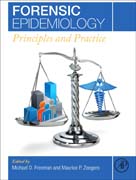
It is an inescapable fact that causation, both generally (in populations), and specifically (in individuals), cannot be observed. Rather, causation is determined when it can be inferred that the risk of an observed injury or disease from a plausible cause is greater than the risk from other plausible causes. While many causal evaluations performed in forensic medicine are simplified by fact that the circumstances surrounding the onset of an injury or disease clearly rules out competing causes (e.g. a death following a fall) there are many cases that present a more complicated picture. It is these types of investigations, in which an analysis of comparative levels of risk from competing causes is required to arrive at a reliable and accurate determination of cause, that forensic epidemiology (FE) is directed at. In Forensic Epidemiology the authors present the legal and scientific theories underlying the methods by which risk is used in the investigation of individual causation. Methods and principles from epidemiology are combined with those from a multitude of other disciplines, including general medicine, pharmacology, forensic pathology, biostatistics, and biomechanics, inter alia, as a basis for investigating the plausibility of injury and disease exposures and mechanisms. The ultimate determination of the probability of causation (PC) results from an assessment of the strength of association of the investigated relationship in the individual, based on a comparison between the risk of disease or injury from the investigated exposure versus the risk of the same disease or injury occurring at the same point in time in the individual, but absent the exposure. The principles and methods described in Forensic Epidemiology will be of interest to those who work and study in the fields of forensic medicine, epidemiology, and the law. Historical perspective on how epidemiologic evidence of causation has been used in courts in U.S. and EuropeTheory and science underlying the use of risk to assess individual causationPrimer on epidemiologic methods, and various measures used to arrive at individualized comparative risk assessments and PCThe use of statistical methods applied to publicly available data for ad hoc analysis of PC applicable to the specific circumstances of a caseBackground on adjunctive disciplines, including forensic pathology, death investigation, biomechanics, and survival analysis INDICE: 1. History of Epidemiology in the courts 2. History of FE 3. Basic tenets of Epidemiology 4. Different types of epidemiologic studies used in FE 5. Test accuracy 6. Statistical tests used in Epidemiology 7. Probability and the Law 8. Common logical fallacies encountered in FE 9. Causation 10. Sources of data for FE investigation Adjunctive disciplines utilized in FE investigations 11. Medicine 12. Toxicology 13. Pharmacology 14. Biomechanics 15. Principles of death investigation Applied Forensic Epidemiology 16. Governmental uses of epidemiologic investigation 17. FE in criminal cases 18. FE in civil cases 19. Toxic tort investigation 20. Product defect investigation 21. Injury litigation 22. Medical negligence 23. Life expectancy projections
- ISBN: 978-0-12-404584-2
- Editorial: Academic Press
- Encuadernacion: Cartoné
- Páginas: 440
- Fecha Publicación: 02/05/2016
- Nº Volúmenes: 1
- Idioma: Inglés
